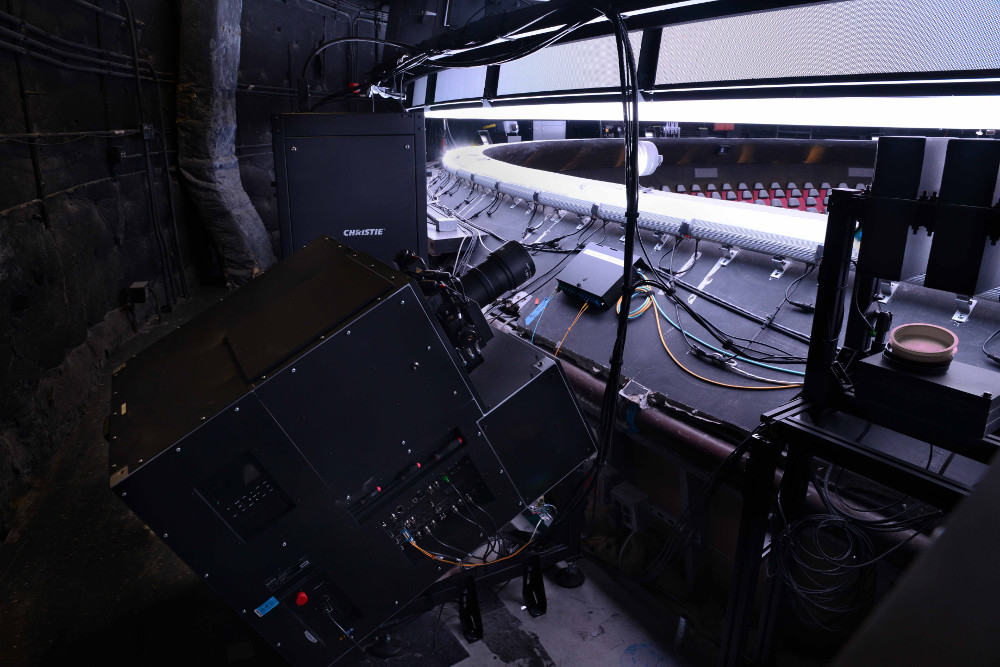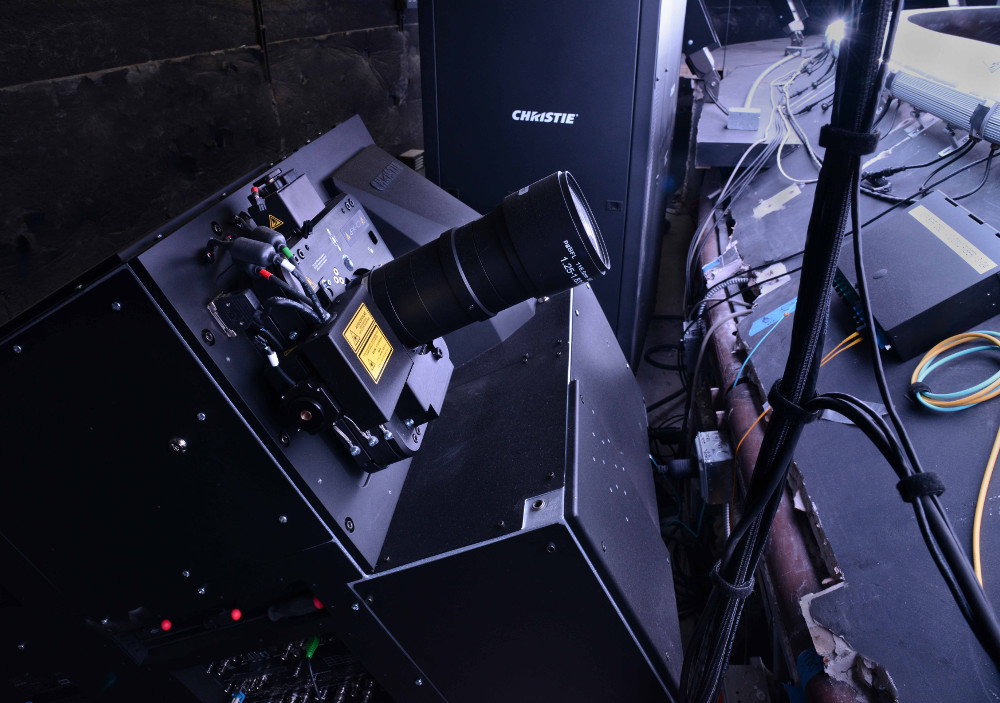The New York-based American Museum of Natural History, where the famous Hayden Planetarium is housed, held a press event on July 17 to celebrate the 50th anniversary of the Apollo 11 Moon Landing, along with the 150th anniversary of the founding of the museum. If you have never been there, you need to if in New York. It is one of the best museums and planetariums on the planet.

During the event we learned about the moon rocks and meteorites on exhibit and then traveled to the Hayden Planetarium for a special presentation on the moon landing. The presentation pulled together 3D photogrammetry of the moon’s surface with laser altimeter data to create a very detailed textured rendering of the moon. Overlaid on this was the orbit flight path of Apollo 11 along with the descent path of the landing module. During the decent, warnings of computer failures and rapidly declining fuel levels punctuated the actual astronaut narrative that was played in the simulation. This showed how Armstrong disabled the computer-controlled navigation system as they were headed for an area with large boulders and he manually guided the space craft to a safe landing. For the first time, we were able to see a simulation of a God’s eye view of the landing which showed the irregular flight path the capsule followed in Armstrong’s quest to find a safe place to land. Personally, I might have preferred an out-the-window simulated view, which I was told was possible as they have full models of the landing module as well. Maybe next time.
But the big news for me was the unveiling of a new planetarium projection solution that has been five years in the making. This collaborative effort started with the team from the Hayden in 2014 when Christie was in the early stages of development of a unique dual-modulated projection system based on Christie patented technology developed specifically for the non-DCI cinema market. Planetarium Sr. Director Benjy Bernhardt and Chief Video Engineer, Jeff Galitzer saw a demo of this and were awed by the black levels possible with a projection system – something they had never seen before. As a result, a project was started with Larry Paul, executive director of technology & custom solutions at Christie Digital.
In a lengthy conversation I had with all three after the presentation, Paul said that one of the Christie strengths is the ability to develop customized solutions to fit very specific market requirements. And, it was clear from his conversations with the Hayden Planetarium, that they wanted to create the most advanced solution in the industry and they had the knowledge (and budget) to carry out that mission. So, the collaboration began.
Paul was quick to point out however, that while there are some common needs and some technology can be used in any planetarium, theme park or simulation solution, the requirements of the Hayden Planetarium were demanding and required a solution that was beyond the capabilities of what was on the market from any manufacturer.
As a first step, the existing projectors were replaced with first generation RGB laser projectors in 2015, but these were big and did not yet meet the performance needs of the Planetarium. At the same time as the temporary projectors were being installed, new seating and a new audio system was also being introduced with a completely new screen skin. Considerations in the design of the screen are the size of the micro-perfs (trade-off between sound transmissivity and quality and possible moiré or artifacts with the image); elimination of speckle from the RGB lasers (surface flatness and texture); and gain (low gain is actually desired to eliminate light from one part of the dome illuminating another and reducing contrast).
The Hayden Planetarium and Christie worked with Spitz to design, manufacture and install the screen. A 0.38 gain screen design was chosen that improved the checkerboard contrast ratio from 3.5:1 in an older solution to an impressive 10:1 with an ANSI pattern. I know 10:1 does not sound very good, but in a domed environment where any light reduces contrast, that is actually quite good. With actual planetarium specific content, the system performance is far superior to other dome environments.
The new 4K resolution projector is called the Christie Eclipse and it will be commercially launched later this year but the first six of them have been installed in the Hayden Planetarium already. The projector itself is a 6-DMD optical design with the first stage acting as a pre-modulator. This takes the standard 3-chip DLP optical block sequential contrast from around 2000:1 to over 20M:1 (in a black room on a flat screen). This makes it the first High Dynamic Range (HDR) planetarium solution that we know of.


The projection head is now much smaller than the temporary solution and has the RGB laser source located from 6-15 meters away and fiber-optically coupled. Light output from the Christie Eclipse is capable of up to an impressive 30K lumens, but the system is toned way down for this application. When installed in the dome with the new screen, peak luminance is only 0.75 FtL (2.5 m²). Such numbers can be deceiving in a domed environment. I can attest that when dark adapted with the image of the moon display on the dome, it is plenty bright, but not too bright.
One of the big challenges was to be able to control the very darkest tones – i.e. those few dozen code values above black. Normal projectors crush the black, meaning those code values can’t be distinguished and black is dark gray. The new Eclipse projector solved this issue with the dual modulation optical design and careful control of the EOTF. Interestingly, Galitzer and Bernhardt told me that the PQ curve can’t be used as there is too much separation between code values in the very low end of the curve. As a result, they continue to experiment with different gamma curves to seek out the best low light level performance.
One other design requirement was the elimination of masks or optical blending plates that are usually used to merge the images of projectors where they overlap. Such physical plates block light allowing for the darkest levels in the blend zone. These blend zone essentially sets the black level floor. Again, the double-modulated HDR Eclipse projector solves this problem allowing digital blending without the plates.
The projectors also include internal blending and warping. This was a smart system design solution allowing various pieces of content to be only parsed into 6 port views and sent to the projectors so that content does not have to be pre-warped.
Hemispherical content can now be created to play on the new HDR-capable system. Not only can such new content take advantage of a deep black levels that should now come very close to mimicking the actual night sky in a very dark part of the globe (the design objective), but with RGB laser sources, it will also be close to a BT.2020 color gamut. I have no idea if quasars or other objects have such colors, but the capability now exists.
The Planetarium is now being used to produce such next-generation content as desktop monitors are inadequate for seeing the dark details. What they are discovering is that the new projection system is revealing flaws in the content that were never seen before (masking errors, elevated black areas, noise, etc.) This is exactly the same thing that is happening in LED cinema post production houses where deep black levels can now be discerned.
Content for the system is being developed in an 8Kx8K 10-bit format. This is parsed into 6 segments that reside on dedicated servers for each projector, with fiber delivery to the projector head. Six AJA Key-pro Ultra playback devices is also connected to each projector as a backup. Content is typically formatted as uncompressed EXR files or ProRes HQ 422. Playback will be at 60 frames per second, but the projectors can be upgraded to play at 120 fps later, if needed.
Unfortunately, the Apollo demonstration and a test video I saw after the presentation don’t showcase the full potential of this new projection solution. Their test clip was mastered for an SDR display solution, but the black levels were quite dark nonetheless.
The real test will come when a new HDR production is ready in the January 2020 time frame. This will take advantage of the full dynamic range of the system and should blow away audiences. Such high contrast images are also likely to look much more “3D like” which may give the impression of a volume of images filling the dome above you. I can’t wait to see that. (CC)

